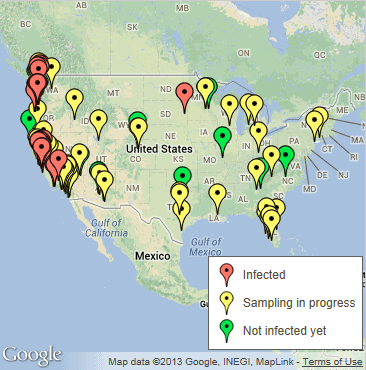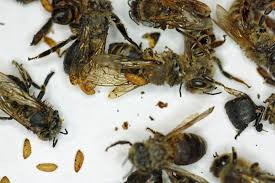Queen starves due to lack of workers in the hive...
ZomBee Watch is a citizen science project sponsored by the San Francisco State University Department of Biology, the San Francisco State University Center for Computing for Life Sciences and the Natural History Museum of LA County. ZomBee Watch was initiated as a follow-up to the discovery that the Zombie Fly Apocephalus borealis is parasitizing honey bees in California and possibly other areas of North America. You can read or download a copy of our original scientific paper, A New Threat to Honey Bees, the Parasitic Phorid Fly Apocephalus borealis, for free from PLoS One.
Honey bees infected by the Zombie Fly leave their hives at night and are attracted to nearby lights where they become stranded and eventually die. The presence of fly larvae in up to 18% of active foragers in some California honey bee hives makes the Zombie Fly a potential contributor to hive declines. This would be especially likely if Zombie Fly infection is widespread and higher in areas that are experiencing hive declines. We founded ZomBee Watch to find out how widespread Zombie Fly parasitism is and to learn how often unparasitized honey bees are attracted to lights at night for other reasons.
ZomBee Watch has three main goals.
To determine where in North America the Zombie Fly Apocephalus borealis is parasitizing honey bees.
To determine how often honey bees leave their hives at night, even if they are not parasitized by the Zombie Fly.
To engage citizen scientists in making a significant contribution to knowledge about honey bees and to become better observers of nature.
There are many ways you can get involved. It can be as easy as collecting honey bees that are under your porch light in the morning, under a street light or stranded on sidewalks. If you are a beekeeper, setting up a light trap near one of your hives is the most effective way to detect ZomBees. It's easy to make a simple, inexpensive light trap from materials available at your local hardware store. To test for the presence of Zombie Fly infection all you need to do is put honey bees you collect in a container and observe them periodically. Infected honey bees give rise to brown pill-like fly pupae in about a week and to adult flies a few weeks later. View the tutorial.
In California, parasitism begins to increase in early June and peaks in the fall and early winter months. Most records of the fly from other parts of North America (such as the Midwest and Northeast) are from late May to September, which is the most likely time that parasitism will be observed by citizen scientists in those areas.
Not all honey bees attracted to light produce Zombie Fly pupae. Whether or not you find parasitized bees, we are interested in your records.
https://www.zombeewatch.org/theproject#about_ZomBee_watch_


ZomBee Watch is a citizen science project sponsored by the San Francisco State University Department of Biology, the San Francisco State University Center for Computing for Life Sciences and the Natural History Museum of LA County. ZomBee Watch was initiated as a follow-up to the discovery that the Zombie Fly Apocephalus borealis is parasitizing honey bees in California and possibly other areas of North America. You can read or download a copy of our original scientific paper, A New Threat to Honey Bees, the Parasitic Phorid Fly Apocephalus borealis, for free from PLoS One.
Honey bees infected by the Zombie Fly leave their hives at night and are attracted to nearby lights where they become stranded and eventually die. The presence of fly larvae in up to 18% of active foragers in some California honey bee hives makes the Zombie Fly a potential contributor to hive declines. This would be especially likely if Zombie Fly infection is widespread and higher in areas that are experiencing hive declines. We founded ZomBee Watch to find out how widespread Zombie Fly parasitism is and to learn how often unparasitized honey bees are attracted to lights at night for other reasons.
ZomBee Watch has three main goals.
To determine where in North America the Zombie Fly Apocephalus borealis is parasitizing honey bees.
To determine how often honey bees leave their hives at night, even if they are not parasitized by the Zombie Fly.
To engage citizen scientists in making a significant contribution to knowledge about honey bees and to become better observers of nature.
There are many ways you can get involved. It can be as easy as collecting honey bees that are under your porch light in the morning, under a street light or stranded on sidewalks. If you are a beekeeper, setting up a light trap near one of your hives is the most effective way to detect ZomBees. It's easy to make a simple, inexpensive light trap from materials available at your local hardware store. To test for the presence of Zombie Fly infection all you need to do is put honey bees you collect in a container and observe them periodically. Infected honey bees give rise to brown pill-like fly pupae in about a week and to adult flies a few weeks later. View the tutorial.
In California, parasitism begins to increase in early June and peaks in the fall and early winter months. Most records of the fly from other parts of North America (such as the Midwest and Northeast) are from late May to September, which is the most likely time that parasitism will be observed by citizen scientists in those areas.
Not all honey bees attracted to light produce Zombie Fly pupae. Whether or not you find parasitized bees, we are interested in your records.
https://www.zombeewatch.org/theproject#about_ZomBee_watch_

I can totally understand this in Hawai'i around 2005 we were invaded by an invasive species. A wasp from Africa that laid their eggs in the Wiliwili Tree...In less then 6 months almost every tree was dead!
Every April they used to show their orange blooms. Hawaiians said when the tree blooms it's the time to watch for sharks in the ocean.


Every April they used to show their orange blooms. Hawaiians said when the tree blooms it's the time to watch for sharks in the ocean.


No comments:
Post a Comment